Last Updated on September 28, 2022 by Ava

In a hurry? Grab the PDF version of this post by clicking the button to the left <<<.
Last year at this time, which was Spring of 2017 for those listening in the future, I was deep in the throes of the fidget spinner craze. I see you rolling your eyes. Hey, those things were cool! I was attracted to them as a tool to help kids with ADHD since I was diagnosed myself at age 10.
I’d discovered them in October or November of 2016, and I’d spent 4 months or so looking for a design that I could build myself. I tried all of the DIY fidget spinner projects that were EVERYWHERE. The first ones I made were built from skateboard bearings with a split ring around them.

The split rings worked well. They were nice and heavy, but the design was a little too DIY, you know? They didn’t look that great. I saw creators making spinners from everything under the sun. There were wooden designs. I even saw one designer making them from stone.
In February, I came across a guy on YouTube who had made some great-looking spinners from bicycle derailleur sprockets, and bike chain. I had my design. I started stocking up on parts, and before long, I’d become a two-person fidget spinner factory called Spinful.
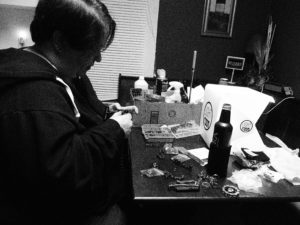
I spent my Friday nights at the kitchen table building spinner after spinner. They looked great, and they were flying off my eBay account like crazy. Somewhere in the middle of everything, I put up a WordPress site on Spinful.net and started blogging and listing my creations using WooCommerce.
I was having a blast with the business, and it was making decent money in the height of the craze. Once summer hit, and the kids came home from school, the business tanked. In this episode, I’m going to talk about what I did wrong, what I did right, and the lesson that I learned about ecommerce on WordPress. Stay tuned.
This episode is sponsored by Shopify.
You’ve been thinking about building an online store, but you were just unsure how to get started. With Shopify, you can sell online, on social media, in store, or out of the trunk of your car.
No matter what your vision is, Shopify has you covered. Get started with a 14-day free trial today, no credit card required.
Visit HeyYoAva.com/Shopify.
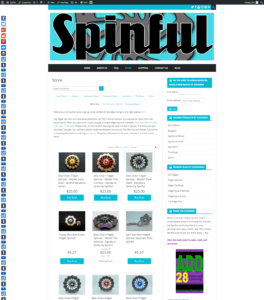
I actually started Spinful on Shopify, but moved over to WordPress because I know that platform much better. I knew that I could install WooCommerce and have great control over my SEO, etc. I’d also spotted a great-looking theme that would make my shop look amazing.
I ran into several hurdles with the website after the move. The first one was an issue with WooCommerce displaying variables like size or color. With fidget spinners coming in so many colors, I had to be able to differentiate. After a little research showed it was a known issue that didn’t have an ETA for getting fixed, I ditched WooCommerce for Ecwid.
Ecwid is a lesser known shopping cart platform. I think they’re based in Norway, maybe. I’m not sure, but the shop ended up coming together and looking decent. I didn’t like Ecwid as well as WooCommerce because I couldn’t use the cool theme I’d found, and I didn’t have as much control over SEO. It felt second best.
I ran with it anyway, and made a decent amount of sales. Once WooCommerce got their crap together, I did switch the store back over. All of this happened in about a 4-month period. It was a lot of doing, and not enough selling to be worth the work I was putting in with building spinners, blogging, and running a website.
Lesson 1. Choose Your Platform and Stick With It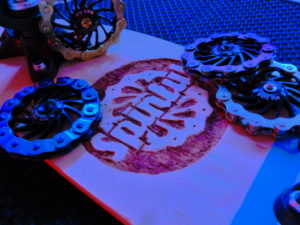
Before you jump into ecommerce with both feet, I suggest that you decide which platform you want to use. Choose one, and stick with it. If it’s not working, adjust and make it work.
Price point was huge for me. With more than a decade of experience with WordPress, I knew that I could build and run my store on WordPress for pretty much nothing more than I was already paying to host my websites. That $29 per month price tag with Shopify was a deal-breaker at the time.
In addition to the price tag, I couldn’t justify learning a whole new platform, so for me, Shopify’s cons outweighed the pros. I was wrong…more on that later.
Do your research. If you’re new to websites altogether and a store is all you want, then go with Shopify. If you think that you might want more aspects to your web presence in the future, I say WordPress all the way.
It really depends on you. You can try both platforms for free, so why not get a free trial and see how they feel?
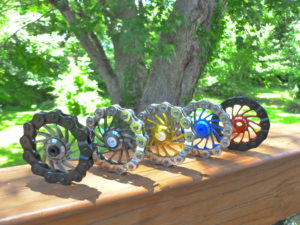 Lesson 2. Choose Your Niche
Lesson 2. Choose Your Niche
The fidget spinner niche was super hot. Who doesn’t know about them? All the school kids had them. In fact, school kids were the target audience and driving force behind the fad…which brings me to my first point: don’t choose a niche because it’s a fad.
The spinners pretty much sold themselves. I made a good amount of money in a very short amount of time. I thought that I’d seen past the fad. The phenomena was supported by multiple communities which included:
- ADHD/Autism
- EDC (Everyday carry)
- Collectors
It seemed that fidget spinners had captured the interest of kids and adults alike. I mean, here I was a 40-something year old woman totally immersed in the idea. I was sure that they were a fad that would last. You know, like Rubik’s cube or Yo-Yo’s?
Maybe they are, but the space I carved for myself completely dried up. Even though my design was unique, it seemed like people were more attracted to the spinners that adhered to a certain design. There were a few hiccups with the parts I was using as well that made people hesitant to buy my spinners.
For example, my spinners used an oddball 606 bearing. Even though it was ceramic and top of the 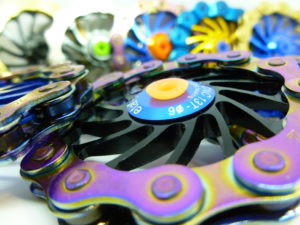 line, people preferred the r188 bearings made of steel. They were an inferior bearing, but replacements were more readily available.
line, people preferred the r188 bearings made of steel. They were an inferior bearing, but replacements were more readily available.
The bearing also complicated the availability of the buttons that screwed into the center of the spinner so you could hold it securely with your fingers. I couldn’t find buttons in different materials as could be used with other spinners. I was limited to adapting and using the bushings that came with the sprockets.
They looked good enough, but it just wasn’t the same experience.
When you choose your niche, pick it for longevity. Also, choose something that has been around for a while and proven it’s sales possibilities. There’s nothing wrong with jumping on a bandwagon late. By doing so, you come in with a lot more insight than people who jumped on at the beginning. If the niche is viable, there are still plenty of sales to be made.
The most important reason to pick a certain niche though, is because you are passionate about it.
I was passionate about fidget spinners because I saw them as a device that could have really helped me as a kid struggling with ADHD. I wanted to tell everyone in the world about them. Even so, it wasn’t enough to really make me stick with things when they got slow. It’s important to consider all of these lessons if you’re considering ecommerce.
I’m about to jump in again, and I plan to do things totally different this time.
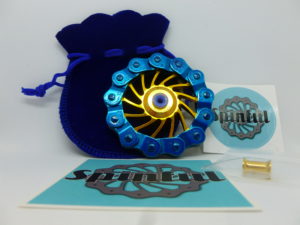 Lesson 3. Use Instagram
Lesson 3. Use Instagram
Photography was a huge part of Spinful. If you want to see what I mean, be sure to grab the show notes for this episode at HeyYoAva.com/Episode22.
While I built spinners, my partner would take pictures…then I would take pictures. I took more than 1,000 pictures in just a few months. I bought a mini skateboard at Five Below and carved the Spinful logo into it for use as a photo prop.
My image game was hard to beat.
I built up a following of 600 people on Instagram doing pretty much nothing except posting images. We would have a Friday night build and picture session, then I used Gramblr to post images from my PC daily. The Spinful Instagram is actually still live at Instagram.com/spinful/ if you’d like to take a look.
Definitely use Instagram as a part of your ecommerce marketing plan. I had great results, and I put in very little effort. People want to see your products. They want to see them being used, and depicted in cool ways. Instagram also has a robust advertising platform via Facebook if you decide to invest in your marketing at any point. Social Media marketing is the absolute best because you can target multiple demographics rather than just location like with search engine ads.
Lesson 4. Unique Isn’t Always The Best Approach
I gravitate toward unique. I condone it. I endorse it. Being unique is a huge part of who I am; however, it’s not always the best approach.
When I decided to sell fidget spinners online, I started off selling the same plastic crap that everyone else was selling. Once I found a unique design though, I felt like I really had something I could get behind. I thought the one-of-a-kind aspect would carry my project further.
I actually had other sellers that I networked with ask why I didn’t sell the more mainstream designs. I thought having a unique design would set me apart. Those sellers are still going strong.
I truly felt like I had a solid product, but it ended up being a catalyst in the demise of that business in reality. Don’t make your product so unique that it’s difficult to accessorize or repair. People will steer away from it for more user-friendly options.
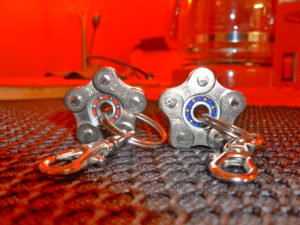
Lesson 5. Selling Online Is No Easier Than Selling Offline
The venue is just different. You still need capital, although maybe not as much. It’s still work, and there’s a method to doing it successfully. If you’re going to sell online, make sure you are passionate enough to do the learning that goes along with the business.
Not only do you have to learn a platform, but you have to learn which methods are working best for building a sustainable business in that niche. If your niche is a good one, then not everyone will be doing it. You may find yourself going through a lot of trial and error to find success.
Which brings me to the final lesson…
Lesson 6. Be Prepared to Fail
There are no guarantees. You can’t just throw up a store, plug in all the right stuff, and boom, get rich. It’s not a “build it and they will come” thing when you go into ecommerce. It’s a “build it and constantly beg them to come via social media, and they might” kind of deal. You may have to pivot a few times.
I will tell you this, if you stick with it and make it work, you will truly have an asset. Let’s talk about that for a minute before we wrap up this episode of The Candid Cashflow Podcast.
Benefits of An Ecommerce Business
First off, ecommerce is expected to be a $4 trillion a year industry by 2020. The money is really just a benefit of success. Ecommerce can mean financial and time freedom for you as an entrepreneur. Personally, I can’t think of anything else I’d rather have. These 2 concepts really embody the essence of my WHY.
Ecommerce allows you to do things that you just can’t do with a physical store. The upfront cost is a lot lower. You can also sell out of your store 24 hours a day, seven days a week without having to hire any extra staff. Not to mention, you can sell all over the world rather than just your local town.
The benefits go on and on. It’s actually hard to find the downside to this business model.
That’s a Wrap
Before I close out this episode, I wanted to say that for my new store, I’m going to be using Shopify. While I’m a WordPress fanatic through and through, I really think that Shopify does ecommerce better for physical products. WordPress works well for digital products still, but for physical items, Shopify is built for that and does it better.
If you want to learn more about Shopify, be sure to check out Episode 8 of The Candid Cashflow Podcast when we discussed dropshipping using that platform. You can grab the show notes for that episode at HeyYoAva.com/Episode8.
I hope you enjoyed this episode of The Candid Cashflow Podcast. I’m happy you stopped by today to listen. I tweaked the format a little today by moving the overview above the intro music and sponsor. If you’re a regular listener, and you like this change, I’d love to hear from you.
If you’d like to subscribe to The Candid Cashflow Podcast, you can do so in your favorite app by visiting HeyYoAva.com/CandidCashflow…now on Spotify!
I release a new episode each Wednesday.
Until next time, turning your passion into cashflow.


Fantastic! Thx!
You’re welcome.